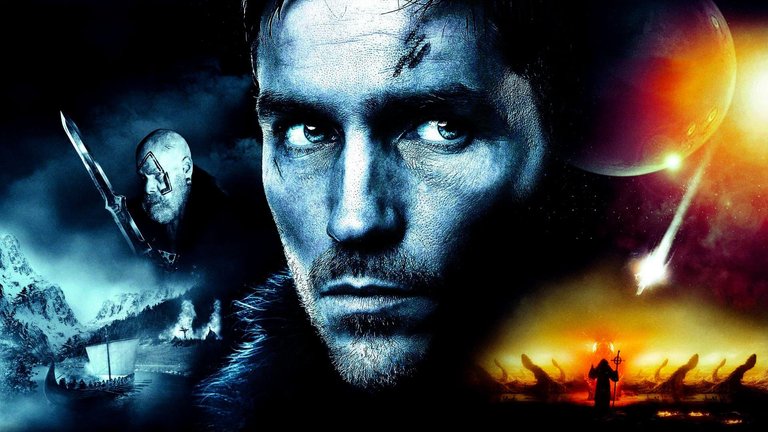Film Review: Outlander (2008)

Beowulf, the Anglo-Saxon poem often regarded as the first significant work of English literature, serves as a fascinating case study how single text can be adapted into very different film, each taking unique liberties with the source material. For instance, the 1999 film The Thirteenth Warrior, starring Antonio Banderas, reimagines the story as a revisionist historical epic. In contrast, the same year saw Beowulf, featuring Christopher Lambert, transport the narrative into a futuristic, post-apocalyptic setting. Following these adaptations, Robert Zemeckis's 2007 animated version sought to remain true to the original text and its historical context. The trend continued in 2008 with Outlander, directed by Howard McCain, which intriguingly attempted to blend science fiction with a period adventure.
The film's script, co-written by McCain and Dirk Blackman, speculates on the event that may have inspired early Germanic people to reinterpret their legends, ultimately leading to the creation of Beowulf. The answer to this question is provided at the beginning of the film when an alien spaceship crashes on Earth, leading to the survival of a human-like alien named Keinan (played by Jim Caviezel). Keinan, aided by the ship's computer, quickly learns the local geography, history, customs, and language, which proves advantageous when he is captured by Norsemen and brought to a village ruled by Chieftain Rothgar (played by John Hurt). As Rothgar prepares to marry his daughter, Freya (played by Sophie Myles), to young warrior Wulfric (played by Jack Huston), Keinan becomes aware of the nearby Chieftain Gunnar (played by Ron Perlman), whose village was recently destroyed in a terrible massacre. Keinan, however, knows that the massacre was perpetrated by "Morwen," a monstrous alien that arrived on Earth as a stowaway on Keinan's spaceship. Keinan decides not to let Rothgar and his villagers suffer the same fate, devising a plan to trap and kill the seemingly unstoppable and invincible creature.
Outlander was widely panned by critics, and the primary reason for this can be traced back to the film's fundamental premise – Vikings vs. alien monster – which many found too ridiculous for the rest of the film to be taken seriously, and considered it implausible crossover that undermined both genres.
However, if one can suspend disbelief regarding its outlandish premise—akin to certain popular but controversial documentary series that tarnished the reputation of what used to be the History Channel—Outlander emerges as a surprisingly competent film. From a technical standpoint, McCain’s work justifies its considerable budget with impressive special effects and visually convincing Canadian landscapes that effectively double for Iron Age Scandinavia. Furthermore, there are earnest attempts made to reconstruct elements of Norse culture throughout the film.
The creature Morwen, designed by veteran production designer Patrick Tatopoulos—who has contributed to numerous notable science fiction and horror films since the 1990s—stands out as an impressive adversary for the protagonists. His design captures both menace and intrigue, presenting Morwen as a serious threat that challenges Kainan and his newfound allies.
Moreover, the screenplay does attempt to provide some rationale for Kainan's resemblance to Earth humans and his rapid acquisition of knowledge about primitive Earth societies. Such efforts lend a semblance of credibility to an otherwise fantastical narrative.
Nevertheless, it is precisely this script that also harbours many of the film’s shortcomings. Events unfold with excessive convenience that forces Kainan into confrontations with Morwen using only Iron Age technology—a narrative contrivance that feels forced. Additionally, certain plot elements are clichéd; for instance, Freya is introduced as a strong female character yet becomes entangled in an obligatory romantic subplot.
The film's most significant misstep lies in the revelation that Morwen is not only a monster but ačlso a victim of conquest and genocide by Keinan and his people, an attempt to imbue the film with "politically correct" credentials. This twist happens relatively late and seems too convenient to be convincing.
Despite these script flaws, McCain demonstrates commendable directorial skills; he utilises his budget effectively while crafting thrilling action sequences. The violence portrayed is visceral yet grounded in realism rather than gratuitous exploitation. The cast delivers strong performances; Caviezel’s portrayal of Kainan is notably stoic and reserved. Meanwhile, Sophie Myles successfully subverts typical "eye candy" stereotypes by embodying a robust Norse woman rather than merely serving as decorative support.
Despite some pacing issues and anachronistic subplots (such as the character of Christian appearing centuries before the Norse accepted Christianity), Outlander offers a satisfying blend of science fiction, horror, and period adventure. While it may not be the best representatives of those genres, there are certainly worse ways to spend two hours than watching and there are definitely worse ways to adapt Beowulf.
RATING: 6/10 (++)
Blog in Croatian https://draxblog.com
Blog in English https://draxreview.wordpress.com/
InLeo blog https://inleo.io/@drax.leo
Hiveonboard: https://hiveonboard.com?ref=drax
Rising Star game: https://www.risingstargame.com?referrer=drax
1Inch: https://1inch.exchange/#/r/0x83823d8CCB74F828148258BB4457642124b1328e
BTC donations: 1EWxiMiP6iiG9rger3NuUSd6HByaxQWafG
ETH donations: 0xB305F144323b99e6f8b1d66f5D7DE78B498C32A7
BCH donations: qpvxw0jax79lhmvlgcldkzpqanf03r9cjv8y6gtmk9